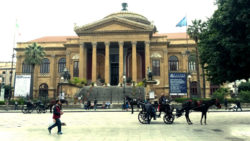Palermo, Sicily tourist information.
 Palermo is the capital of the Italian island of Sicily, one of those cities with its own very distinct, almost tangible atmosphere, a place of mystery where reality often outperforms the traveller’s imagination and preconceived stereotypes. The 12th-century Palermo Cathedral houses royal tombs, while the huge neoclassical Teatro Massimo is known for opera performances. Also in the center are the Palazzo dei Normanni, a royal palace started in the 9th century, and the Cappella Palatina, with Byzantine mosaics. Busy markets include the central Ballarò street market and the Vucciria, near the port.
Palermo is the capital of the Italian island of Sicily, one of those cities with its own very distinct, almost tangible atmosphere, a place of mystery where reality often outperforms the traveller’s imagination and preconceived stereotypes. The 12th-century Palermo Cathedral houses royal tombs, while the huge neoclassical Teatro Massimo is known for opera performances. Also in the center are the Palazzo dei Normanni, a royal palace started in the 9th century, and the Cappella Palatina, with Byzantine mosaics. Busy markets include the central Ballarò street market and the Vucciria, near the port.
The city was founded in 734 BC by the Phoenicians as Ziz (‘flower’). Palermo then became a possession of Carthage, before becoming part of the Roman Republic, the Roman Empire and eventually part of the Byzantine Empire, for over a thousand years. It is a city rich in history, culture, art, music and food. Numerous tourists are attracted to the city for its good Mediterranean weather, its renowned gastronomy and restaurants, its Romanesque, Gothic and Baroque churches, palaces and buildings, and its nightlife and music.
Palermo tourist attractions
Central Palermo can be toured on foot, and the best place to start in the morning is with a walk through one of its lively street markets, followed by an overview of the city from the roof of the historic cathedral. Palermo’s chaotic and bustling markets are famous and the range of products on offer – seafood, colourful fruit and vegetables, random junk – makes for a fascinating wander.
Nine monuments, the Royal Palace and Palatine Chapel, the Zisa Palace, Palermo Cathedral, the Palermitan Churches of San Giovanni degli Eremiti, Santa Maria dell’Ammiraglio and San Cataldo, the Admiral’s Bridge, and the cathedrals of Monreale and Cefalù provides, in UNESCO’s words, “an outstanding example of a socio-cultural syncretism between Western, Islamic, and Byzantine cultures.